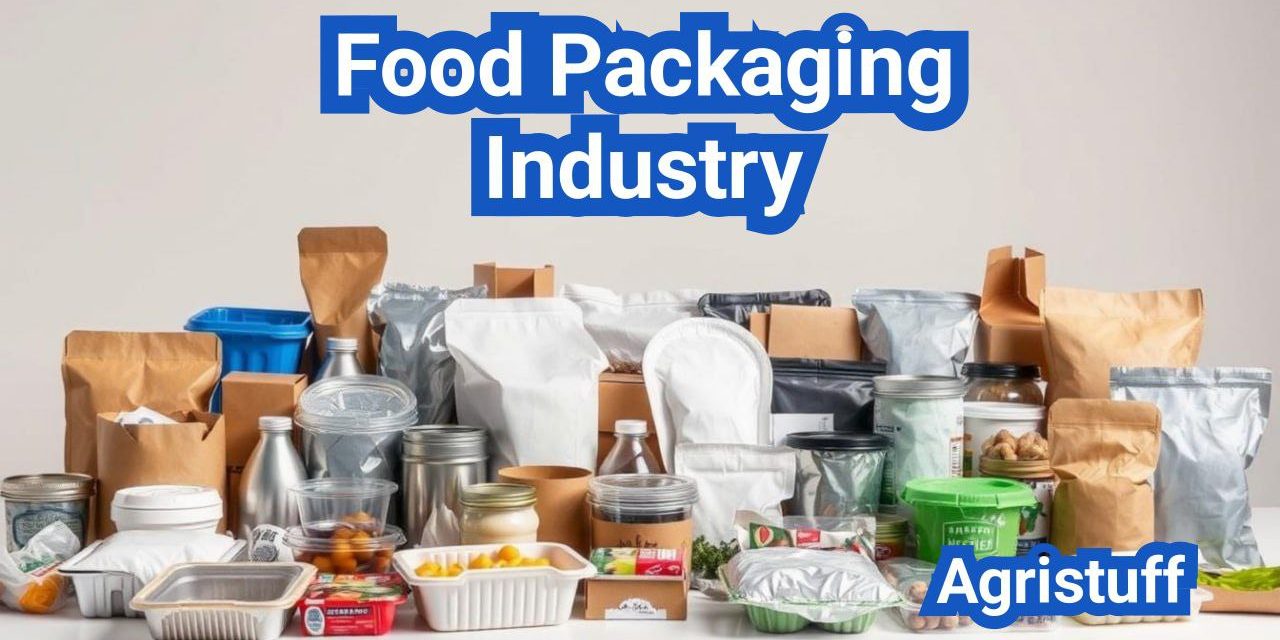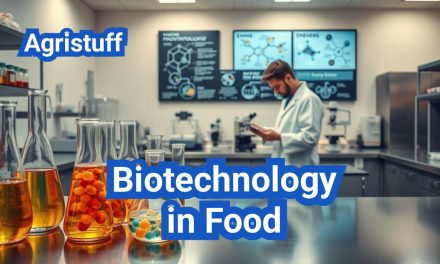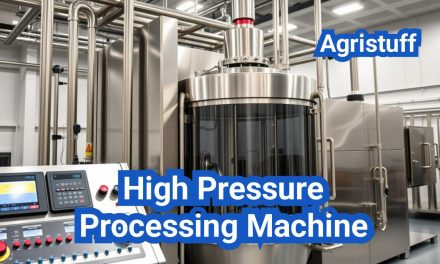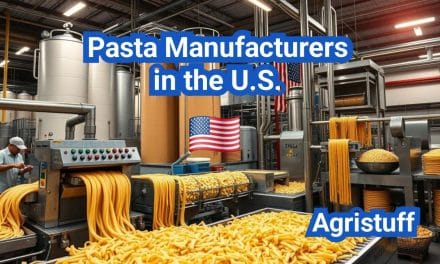The U.S. food packaging industry is a complex sector that involves various materials and converters, with regulations playing a crucial role in ensuring safety and compliance.
The industry in the US utilizes a range of food packaging materials, from plastics and glass to paper and bioplastics, each with its own set of regulations and standards.
The regulatory framework, including FDA food packaging regulations, governs the use of these materials, ensuring they meet safety standards for consumer use.
Key Takeaways
- The U.S. food packaging sector is complex and multifaceted.
- Various materials are used, each with its regulations.
- FDA regulations play a crucial role in ensuring safety.
- Converters are essential in the production process.
- The industry must comply with numerous standards.
Overview of the Food Packaging Industry in the U.S.
With the rising demand for packaged foods, the food packaging industry in the U.S. is experiencing significant growth and transformation. The industry is driven by various factors, including consumer preferences, technological advancements, and regulatory requirements.
Current Market Size and Growth Projections
The U.S. food packaging market has seen substantial growth in recent years, driven by the increasing demand for packaged foods. According to market research, the food packaging industry is projected to continue growing at a steady rate over the next few years.
Market Size: The current market size of the food packaging industry in the U.S. is estimated to be in the range of hundreds of billions of dollars.
| Year | Market Size (Billions) | Growth Rate (%) |
|---|---|---|
| 2020 | 150 | 3.5 |
| 2021 | 155 | 4.2 |
| 2022 | 162 | 4.5 |
Major Players and Competitive Landscape
The U.S. food packaging industry is highly competitive, with numerous players operating in the market. Some of the major players include:
- Amcor
- Sealed Air
- Ball Corporation
- Graphic Packaging International
These companies are focusing on innovative packaging solutions, sustainability, and cost-effectiveness to gain a competitive edge.
Regional Distribution and Manufacturing Hubs
The food packaging industry in the U.S. is distributed across various regions, with major manufacturing hubs located in:
- California
- Illinois
- Ohio
- Pennsylvania
These regions offer strategic advantages in terms of logistics, raw material availability, and access to major markets.
How to Select the Right Food Packaging Materials

The right packaging material can make a significant difference in maintaining the freshness and integrity of food products. With various options available, food manufacturers must carefully evaluate their choices to ensure they meet the required standards for safety, sustainability, and consumer appeal.
Evaluating Plastic Packaging Options
Plastic packaging is widely used in the food industry due to its versatility, cost-effectiveness, and ability to preserve food freshness. However, it also faces criticism for its environmental impact. When evaluating plastic packaging options, consider factors such as:
- Barrier properties to prevent moisture and oxygen transmission
- Compatibility with the food product and packaging machinery
- Recyclability and sustainability
Key benefits of plastic packaging include: its ability to be molded into various shapes and forms, its relatively low cost, and its effectiveness in preserving food quality. However, it’s essential to weigh these benefits against the environmental concerns associated with plastic waste.
Implementing Paper and Paperboard Solutions
Paper and paperboard packaging offer a sustainable alternative to plastic, with benefits including biodegradability and recyclability. When implementing paper and paperboard solutions, consider:
- Strength and durability to withstand handling and transportation
- Printability for branding and labeling purposes
- Barrier coating options to enhance moisture resistance
Paperboard cartons, in particular, are popular for packaging food products such as cereals, snacks, and frozen meals. They offer a cost-effective and sustainable solution that can be customized to meet specific product requirements.
Utilizing Metal Packaging: Aluminum and Steel
Metal packaging, including aluminum and steel, is valued for its excellent barrier properties, durability, and recyclability. When utilizing metal packaging, consider:
| Material | Benefits | Common Applications |
|---|---|---|
| Aluminum | Lightweight, corrosion-resistant, and highly recyclable | Cans for beverages, soups, and vegetables |
| Steel | Strong, durable, and resistant to corrosion | Cans for meats, vegetables, and soups |
Aluminum cans, for example, are widely used for beverages due to their lightweight and recyclable nature. Steel cans, on the other hand, are often used for canned goods that require higher strength and durability.
Determining When to Use Glass Packaging
Glass packaging is another popular option, particularly for products that require premium packaging and a high level of product visibility. When determining whether to use glass packaging, consider:
- Product visibility and branding
- Barrier properties to prevent contamination
- Sustainability and recyclability
Glass packaging is often used for products such as sauces, condiments, and specialty foods, where the premium appearance and barrier properties of glass are valued.
Choosing Appropriate Packaging Formats for Different Food Products
The packaging format chosen for a food product significantly impacts its shelf life and consumer convenience. Different food products have unique requirements that necessitate careful selection of packaging formats to ensure optimal preservation, safety, and presentation.
Assessing Rigid vs. Flexible Packaging Benefits
Rigid packaging offers durability and protection for products that require it, such as canned goods or bottled beverages. On the other hand, flexible packaging provides versatility and convenience for products like snacks or pouches. The choice between rigid and flexible packaging depends on the product’s characteristics, distribution channels, and consumer preferences.
| Packaging Type | Benefits | Examples |
|---|---|---|
| Rigid Packaging | Durable, protective | Canned goods, bottled beverages |
| Flexible Packaging | Versatile, convenient | Snack pouches, stand-up pouches |
Designing Primary, Secondary, and Tertiary Packaging Systems
Effective packaging involves a multi-layered approach, including primary, secondary, and tertiary packaging. Primary packaging directly contains the product, such as a plastic bottle or a pouch. Secondary packaging is used to group multiple primary packages together, like a cardboard box. Tertiary packaging involves bulk packaging for transportation and storage, such as pallets or crates.
Matching Packaging to Product Shelf Life Requirements
The packaging format must be aligned with the product’s shelf life requirements to ensure that it remains safe and fresh for consumption throughout its intended shelf life. Factors such as barrier properties, packaging material, and sealing techniques play a crucial role in determining the product’s shelf life.
By carefully assessing the benefits of rigid and flexible packaging, designing comprehensive packaging systems, and matching packaging to product shelf life requirements, manufacturers can optimize their packaging formats to meet the needs of different food products.
Implementing Advanced Food Packaging Technologies

Advanced food packaging technologies are revolutionizing the way we preserve and consume food products. These technologies not only enhance product safety but also significantly extend shelf life, making them a crucial component in the food packaging industry.
Setting Up Aseptic Packaging Systems
Aseptic packaging is a process that involves sterilizing the packaging material, filling it with sterilized product, and sealing it in a sterile environment. This method is particularly effective for products that require a long shelf life without refrigeration.
Key benefits of aseptic packaging include:
- Extended shelf life without preservatives
- Retention of nutritional value and flavor
- Reduced energy costs due to the elimination of refrigeration needs
Applying Modified Atmosphere Packaging (MAP) Techniques
Modified Atmosphere Packaging involves altering the atmosphere surrounding the product to extend its shelf life. This is achieved by replacing the air in the packaging with a gas mixture that inhibits the growth of bacteria and mold.
The most common gases used in MAP are:
- Oxygen (O2)
- Carbon dioxide (CO2)
- Nitrogen (N2)
| Gas | Effect on Food Products |
|---|---|
| O2 | Promotes oxidation, can lead to spoilage |
| CO2 | Inhibits microbial growth, extends shelf life |
| N2 | Inert gas, prevents oxidation and spoilage |
Integrating Active and Intelligent Packaging Solutions
Active packaging involves incorporating components that release or absorb substances into or from the packaged food, enhancing its quality and safety. Intelligent packaging, on the other hand, provides information about the product’s condition, such as freshness indicators or temperature monitors.
Examples of active and intelligent packaging include:
- Oxygen absorbers
- Freshness indicators
- Temperature control devices
Evaluating Cost vs. Benefit of Advanced Technologies
While advanced packaging technologies offer numerous benefits, they also come with increased costs. Manufacturers must weigh the advantages against the expenses to determine the feasibility of implementing these technologies.
Key considerations include:
- Initial investment in equipment and training
- Ongoing costs of materials and maintenance
- Potential savings from reduced waste and extended shelf life
How to Comply with FDA Food Packaging Regulations
Compliance with FDA food packaging regulations is not just a legal necessity but a critical step in maintaining consumer trust. The FDA sets forth guidelines to ensure that food packaging materials and processes do not contaminate food or mislead consumers.
Completing Food Contact Substances Notification
Food contact substances (FCS) are materials that come into contact with food during manufacturing, processing, or storage. The FDA requires notification for new FCS before they can be used. To comply, manufacturers must submit a Food Contact Notification (FCN) that includes detailed information about the substance, its intended use, and safety data.
Implementing FDA Part 117 CGMP Requirements
FDA Part 117 Current Good Manufacturing Practice (CGMP) regulations outline the minimum requirements for the safe manufacture of food products, including packaging. Implementing these regulations involves maintaining a clean and sanitary environment, controlling pests, and ensuring that equipment is properly installed and maintained.
Meeting 21 CFR 101.9 Labeling Standards
Labeling is a critical aspect of food packaging, providing consumers with essential information about the product. The FDA’s 21 CFR 101.9 regulations specify the requirements for nutrition labeling, including the format and content of the Nutrition Facts Panel.
Maintaining Regulatory Documentation and Records
Maintaining accurate and detailed records is crucial for demonstrating compliance with FDA regulations. This includes records of FCS notifications, CGMP implementation, and labeling compliance. Companies should establish robust documentation systems to ensure that all relevant information is captured and easily accessible.
Navigating the USDA FSIS Label Approval Process

Navigating the complexities of FSIS label approval is essential for companies in the food industry. The USDA’s Food Safety and Inspection Service (FSIS) regulates labeling for meat, poultry, and egg products to ensure consumer safety and transparency.
Determining When Generic vs. Sketch Approval Is Needed
The FSIS requires label approval for certain products before they can be sold in the market. There are two main types of label approvals: generic and sketch. Generic approval is used for labels that follow a standard format and do not require prior approval, whereas sketch approval is mandatory for labels that deviate from the standard or include specific claims.
- Generic approval is suitable for products with straightforward labeling.
- Sketch approval is required for labels with special claims or non-standard designs.
Preparing Label Submissions for FSIS Review
To prepare a label submission for FSIS review, manufacturers must ensure that their labels comply with all relevant regulations. This includes providing accurate nutritional information, listing ingredients, and making appropriate handling statements.
- Gather all necessary information and supporting documentation.
- Complete the FSIS label submission form accurately.
- Submit the label for review, either electronically or by mail.
Addressing Common Compliance Issues and Corrections
After submitting a label for approval, the FSIS may identify compliance issues that require correction. Common issues include incorrect nutritional labeling, missing allergen warnings, or improper handling instructions.
To address these issues, manufacturers should:
- Review the FSIS feedback carefully.
- Make the necessary corrections to the labeling.
- Resubmit the revised label for approval.
By understanding the FSIS label approval process and preparing compliant labels, food manufacturers can avoid delays and ensure their products reach the market efficiently.
Implementing Compliant Nutrition Facts and Product Labeling

Ensuring compliance with nutrition facts labeling is vital for food manufacturers. Accurate labeling is not only crucial for consumer safety but also plays a significant role in building trust between manufacturers and consumers.
Updating to the Current Nutrition Facts Panel Format
The FDA has implemented changes to the Nutrition Facts panel to provide consumers with more accurate and relevant information. The updated format includes:
- Adjusted serving sizes to reflect actual consumption amounts
- Calories and added sugars highlighted in bold
- Updated Daily Values for various nutrients
- Inclusion of Vitamin D and potassium information
To comply with these changes, manufacturers must review and update their labeling to reflect the new requirements. This includes ensuring that the Nutrition Facts panel is legible and complies with FDA guidelines.
Ensuring Proper Allergen Declarations
Allergen declarations are critical for consumer safety, particularly for individuals with life-threatening allergies. The FDA requires that food labels declare the presence of major food allergens, which include:
| Major Food Allergens | Examples |
|---|---|
| Peanuts | Peanut butter, peanut oil |
| Tree Nuts | Almonds, walnuts |
| Milk | Lactose, casein |
| Egg | Albumen, egg whites |
| Wheat | Bread, pasta |
| Soy | Tofu, soy milk |
| Fish | Salmon, cod |
| Shellfish | Shrimp, crab |
Validating Claims and Marketing Statements
Food manufacturers often use various claims and marketing statements on their packaging. It is essential to validate these claims to ensure compliance with FDA regulations. Examples include:
- Health Claims: Statements about the relationship between a food or nutrient and a health benefit.
- Nutrient Content Claims: Claims about the level of a nutrient in a food, such as “low fat” or “high fiber.”
- Structure/Function Claims: Statements about the role of a nutrient or food in maintaining normal body functions.
Manufacturers must ensure that these claims are substantiated by scientific evidence and comply with FDA guidelines to avoid misleading consumers.
Working with Regulatory Consultants and Designers
Given the complexity of food labeling regulations, manufacturers often work with regulatory consultants and designers to ensure compliance. These professionals can provide valuable expertise in:
- Interpreting FDA regulations and guidelines
- Designing compliant labeling and packaging
- Conducting label reviews and compliance audits
By collaborating with regulatory experts, manufacturers can minimize the risk of non-compliance and ensure that their labeling meets all relevant requirements.
How to Partner with Packaging Converters and Manufacturers

Partnering with the right packaging converters and manufacturers is crucial for ensuring the quality and efficiency of your packaging operations. In the food packaging industry, the importance of reliable suppliers cannot be overstated.
Identifying and Vetting Potential Suppliers
The process of identifying and vetting potential suppliers is critical. It involves researching their reputation, assessing their production capabilities, and evaluating their quality control measures.
Key factors to consider include their experience in the industry, compliance with regulatory requirements, and their ability to meet your specific packaging needs.
- Check for industry certifications and compliance with regulatory standards.
- Assess their production capacity and flexibility.
- Evaluate their quality control processes and materials used.
Developing Comprehensive Packaging Specifications
Creating detailed packaging specifications is essential for ensuring that your suppliers understand your requirements. This includes specifying materials, dimensions, and any special features required.
Clear specifications help prevent misunderstandings and ensure that the final product meets your expectations.
Negotiating Pricing, Minimums, and Lead Times
Negotiating with suppliers involves discussing pricing, minimum order quantities, and lead times. It’s crucial to find a balance between cost, quality, and delivery time.
| Factor | Considerations |
|---|---|
| Pricing | Compare prices among different suppliers, consider material costs, and production expenses. |
| Minimum Order Quantities | Ensure the minimum order quantity aligns with your inventory needs and storage capabilities. |
| Lead Times | Discuss and agree on realistic lead times that meet your production schedule. |
Establishing Quality Control Protocols
Establishing robust quality control protocols with your suppliers is vital. This includes regular inspections, testing, and compliance with food safety standards.
Quality control measures should be clearly defined and communicated to your suppliers to ensure consistency and reliability.
Working Effectively with Contract Packagers (Co-Packers)

Co-packers offer specialized packaging services that can enhance the efficiency and quality of food packaging. By outsourcing packaging operations to these experts, food manufacturers can focus on their core competencies while ensuring their products are packaged appropriately.
Determining When to Outsource Packaging Operations
Deciding to outsource packaging operations is a significant step that requires careful consideration. Factors such as cost savings, increased efficiency, and the need for specialized packaging expertise are common reasons manufacturers turn to co-packers.
To determine if outsourcing is right for your operation, consider the following:
- Assess your current packaging capabilities and limitations.
- Evaluate the cost implications of outsourcing versus in-house packaging.
- Consider the benefits of specialized packaging expertise.
Evaluating and Selecting the Right Co-Packer
Selecting the right co-packer is crucial for a successful partnership. This involves evaluating potential co-packers based on their experience, capabilities, and compliance with regulatory requirements.
| Evaluation Criteria | Description | Importance Level |
|---|---|---|
| Experience in Food Packaging | Years of experience and familiarity with food packaging regulations. | High |
| Packaging Capabilities | Range of packaging formats and technologies available. | High |
| Regulatory Compliance | Adherence to FDA and USDA regulations, among others. | Critical |
Creating Clear Agreements and Specifications
Once a co-packer is selected, creating clear agreements and specifications is vital. This includes detailing packaging requirements, quality standards, and delivery schedules.
“A well-defined agreement is the foundation of a successful co-packer relationship, ensuring both parties are aligned on expectations and responsibilities.”
Industry Expert
Managing Ongoing Co-Packer Relationships
Managing the relationship with your co-packer is an ongoing process. Regular communication, performance monitoring, and addressing any issues promptly are key to maintaining a successful partnership.
To manage your co-packer effectively:
- Establish regular check-ins to discuss performance and address concerns.
- Monitor quality control and packaging compliance.
- Foster a collaborative environment to drive continuous improvement.
Developing Sustainable Food Packaging Strategies
Sustainable food packaging is no longer a trend, but a necessity for companies looking to reduce their environmental footprint. As consumers become increasingly environmentally conscious, businesses are under pressure to adopt eco-friendly packaging solutions that minimize waste and reduce the use of non-renewable resources.
Incorporating Recyclable and Compostable Materials
One of the key strategies for developing sustainable food packaging is to incorporate recyclable and compostable materials. This can be achieved by using materials such as paper, cardboard, and bioplastics that are designed to be recyclable or compostable. Companies can also explore the use of innovative materials like mushroom-based packaging and seaweed-based packaging.
- Using recyclable materials can help reduce waste and conserve natural resources.
- Compostable materials can reduce the amount of packaging waste sent to landfills.
- Innovative materials can provide unique packaging solutions that are both sustainable and functional.
Safely Using Recycled Content in Food Contact Applications
Another important aspect of sustainable food packaging is the safe use of recycled content in food contact applications. This requires ensuring that the recycled materials comply with FDA regulations and guidelines. Companies must also implement proper testing and validation procedures to ensure the safety and quality of the packaging.
The use of recycled content can help reduce the demand for virgin materials and minimize waste. However, it is crucial to ensure that the recycled materials are safe for use in food contact applications.
Reducing Material Usage Through Innovative Design
Innovative packaging design can play a significant role in reducing material usage and minimizing waste. Companies can explore design options such as minimalist packaging, lightweighting, and optimized packaging shapes. By reducing the amount of material used in packaging, companies can not only reduce their environmental footprint but also lower their production costs.
Measuring and Improving Packaging Sustainability Metrics
To effectively develop sustainable food packaging strategies, companies must be able to measure and track their packaging sustainability metrics. This includes assessing the environmental impact of their packaging, such as carbon footprint, water usage, and waste generation. By monitoring these metrics, companies can identify areas for improvement and implement changes to reduce their environmental footprint.
- Conduct a life cycle assessment (LCA) to evaluate the environmental impact of packaging.
- Set clear sustainability goals and targets for packaging.
- Implement changes to packaging design and materials to reduce environmental impact.
Mastering Recyclability Labeling and Environmental Claims

Navigating the complex landscape of environmental claims and recyclability labeling is essential for food packaging businesses aiming to build consumer trust. As regulations around green marketing continue to evolve, companies must stay informed to avoid compliance issues.
Complying with SB343 and Similar State Regulations
The SB343 regulation in California has set a precedent for other states, emphasizing the need for accurate labeling to prevent consumer deception. Companies must understand the specifics of this regulation and similar state laws to ensure compliance.
- Review current labeling practices against SB343 requirements
- Update labeling to comply with state regulations
- Monitor future changes to state laws regarding environmental claims
Following FTC Green Guides for Marketing Claims
The FTC Green Guides provide crucial guidance on making environmental marketing claims. Adhering to these guides helps companies avoid greenwashing pitfalls and maintain consumer trust.
| Claim Type | FTC Guidance | Example |
|---|---|---|
| Recyclable | Ensure substantial portions are recyclable | “This package is recyclable where facilities exist.” |
| Biodegradable | Specify conditions for biodegradability | “Biodegradable in composting facilities.” |
Obtaining Relevant Third-Party Certifications
Third-party certifications can enhance the credibility of environmental claims. Companies should explore relevant certifications that align with their sustainability efforts.
Some notable certifications include:
- Recyclable certifications from recognized organizations
- Compostable certifications for packaging that meets composting standards
Avoiding Greenwashing Pitfalls
To avoid greenwashing, companies must ensure that their environmental claims are substantiated and clear. Misleading claims can lead to regulatory action and damage to brand reputation.
Best practices include:
- Ensuring claims are specific and supported by evidence
- Avoiding overly broad or vague environmental statements
- Regularly reviewing and updating marketing materials to comply with evolving regulations
By mastering recyclability labeling and environmental claims, food packaging companies can not only comply with regulations but also build a stronger brand image among eco-conscious consumers.
Preparing for Extended Producer Responsibility Requirements

As the food packaging industry evolves, companies must prepare for Extended Producer Responsibility (EPR) requirements. EPR legislation is becoming more prevalent, shifting the responsibility for waste management from local governments to producers. This change has significant implications for food packaging companies, requiring them to rethink their packaging design, material selection, and waste management strategies.
Understanding Current and Upcoming EPR Legislation
To comply with EPR requirements, companies must first understand the current and upcoming legislation. EPR laws vary by state, with some states already implementing regulations while others are in the process of drafting laws. Companies should stay informed about the specific requirements in the states where they operate.
Key aspects of EPR legislation include:
- Producer registration and reporting requirements
- Fees associated with packaging waste management
- Recyclability and reusability targets for packaging
- Labeling requirements for packaging materials
Calculating and Budgeting for EPR Fees
EPR fees are a critical component of the new regulatory landscape. Companies must calculate and budget for these fees to avoid unexpected costs. The fees are typically based on the type and amount of packaging material used.
To manage EPR fees effectively, companies should:
- Conduct a thorough audit of their packaging materials
- Assess the recyclability of their packaging
- Explore alternatives to non-recyclable materials
- Optimize packaging design to minimize waste
Implementing Design for Recyclability Principles
Design for recyclability is a crucial strategy for reducing EPR fees and complying with EPR regulations. By designing packaging with recyclability in mind, companies can minimize their environmental impact and reduce waste management costs.
Best practices for design for recyclability include:
- Using mono-materials instead of mixed materials
- Avoiding contaminants and non-recyclable components
- Simplifying packaging design to facilitate recycling
- Using clear labeling to indicate recyclable materials
Joining Industry Coalitions and Compliance Programs
Joining industry coalitions and compliance programs can help companies navigate EPR requirements and stay up-to-date with regulatory changes. These programs provide valuable resources, including guidance on best practices, updates on legislative developments, and opportunities for collaboration with other industry stakeholders.
By understanding EPR legislation, calculating and budgeting for EPR fees, implementing design for recyclability principles, and joining industry coalitions, food packaging companies can prepare for EPR requirements and maintain compliance in a changing regulatory landscape.
Optimizing Material-Specific Recycling Programs

Material-specific recycling is a key aspect of sustainability in the food packaging industry. Different materials have unique recycling challenges and opportunities, requiring tailored strategies to maximize their recyclability and minimize environmental impact.
Leveraging Aluminum’s High Recycling Value
Aluminum is highly valued in recycling due to its infinite recyclability without loss of quality. To leverage this, companies can implement closed-loop recycling systems where used aluminum packaging is collected and recycled back into new packaging products. This not only conserves natural resources but also reduces energy consumption and greenhouse gas emissions associated with primary aluminum production.
Key strategies include:
- Designing packaging with recyclability in mind
- Implementing effective collection systems for used aluminum packaging
- Partnering with recyclers to ensure high-quality recycled aluminum
Addressing Glass Packaging Recycling Challenges
Glass packaging is 100% recyclable and can be recycled endlessly without losing its quality. However, it faces challenges such as contamination and the need for color sorting. To address these, companies can work on improving consumer education on proper recycling practices and invest in advanced sorting technologies.
Effective measures include:
- Enhancing consumer awareness about the importance of recycling glass
- Implementing deposit return systems to increase glass collection rates
- Collaborating with glass manufacturers to improve recycling processes
Navigating Plastic Recycling Streams and Limitations
Plastic recycling is complex due to the variety of plastic types and the presence of contaminants. Companies can navigate these challenges by focusing on designing packaging for recyclability, using recyclable plastics, and supporting advancements in plastic recycling technologies.
Strategies for improvement:
- Simplifying packaging designs to reduce material variety
- Avoiding the use of non-recyclable plastics
- Investing in chemical recycling technologies for hard-to-recycle plastics
Communicating Recycling Instructions to Consumers
Clear communication with consumers is crucial for the success of material-specific recycling programs. Companies should provide easy-to-understand recycling instructions on packaging labels and through other consumer touchpoints.
Best practices include:
- Using simple, clear language on packaging labels
- Utilizing digital platforms to provide additional recycling information
- Engaging in consumer education campaigns to promote recycling practices
Adapting to Food Packaging Industry Trends
The food packaging industry is on the cusp of a revolution, driven by e-commerce growth and shifting consumer preferences. As companies navigate this changing landscape, they must be prepared to adapt their packaging strategies to meet new demands and stay competitive.
Designing for E-commerce and Direct-to-Consumer Channels
The rise of e-commerce has significantly impacted the food packaging industry, requiring packaging solutions that are optimized for online sales. This includes robust packaging that can withstand the rigors of shipping and handling, as well as packaging that is designed for efficient storage and shipping. Companies are also focusing on creating a memorable unboxing experience for consumers, which can enhance brand loyalty and encourage positive reviews.
To effectively design for e-commerce, companies must consider factors such as material durability, package size optimization, and clear labeling for easy identification during shipping. Additionally, brands are leveraging packaging as a marketing opportunity, incorporating personalized messages and unique designs to engage consumers directly.
Implementing Smart Packaging and Digital Integration
Smart packaging is another significant trend in the food packaging industry, involving the integration of digital technologies into packaging to enhance functionality and consumer engagement. This can include QR codes, RFID tags, and other technologies that provide consumers with additional product information, track freshness, or offer interactive experiences.
The implementation of smart packaging requires careful consideration of factors such as cost, consumer adoption, and data security. Companies must balance the benefits of smart packaging with these practical considerations to create effective solutions.
Responding to Evolving Consumer Preferences
Consumer preferences are continually evolving, with a growing emphasis on sustainability, convenience, and product safety. Food packaging companies must respond to these changing demands by developing packaging solutions that are not only environmentally friendly but also meet the needs of busy consumers and ensure the safety of the products.
- Developing packaging that is recyclable or compostable
- Creating packaging that is easy to open and reseal
- Ensuring packaging is safe for microwave and freezer use
Preparing for Upcoming Regulatory Changes
The food packaging industry is subject to a complex and evolving regulatory landscape. Companies must stay informed about upcoming changes in regulations related to food safety, labeling requirements, and environmental sustainability. Proactive compliance with these regulations is crucial for avoiding costly fines and maintaining consumer trust.
To prepare for regulatory changes, companies should engage with industry associations, monitor regulatory updates, and invest in flexible packaging solutions that can adapt to new requirements.
Creating a Comprehensive Food Packaging Development Plan
Creating a comprehensive food packaging development plan involves several key steps and considerations. This plan is crucial for ensuring that packaging meets consumer needs, complies with regulations, and supports the overall success of the product.
Establishing Cross-Functional Teams and Responsibilities
A successful packaging development plan begins with establishing cross-functional teams. These teams should include representatives from various departments such as R&D, marketing, regulatory affairs, and supply chain management. By bringing together diverse perspectives, companies can ensure that all aspects of packaging development are considered.
Key roles and responsibilities within these teams include:
- Project management: Overseeing the packaging development process
- R&D: Developing new packaging materials and designs
- Regulatory affairs: Ensuring compliance with relevant regulations
- Marketing: Aligning packaging with brand and consumer preferences
- Supply chain management: Managing the procurement and logistics of packaging materials
Building Realistic Timelines for Development and Testing
Developing realistic timelines is essential for successful packaging development. This involves creating a detailed project schedule that accounts for all stages of development, from concept to launch.
| Stage | Timeline | Responsibilities |
|---|---|---|
| Concept Development | 2 weeks | R&D, Marketing |
| Prototyping | 4 weeks | R&D, Supply Chain |
| Testing and Validation | 6 weeks | R&D, Regulatory Affairs |
| Production and Launch | 8 weeks | Supply Chain, Marketing |
Implementing Validation and Shelf-Life Testing Protocols
Validation and shelf-life testing are critical components of packaging development. These tests ensure that packaging maintains its integrity and protects the product throughout its shelf life.
Shelf-life testing protocols should include:
- Physical testing: Assessing the durability and performance of packaging
- Chemical testing: Evaluating the compatibility of packaging materials with the product
- Microbiological testing: Ensuring packaging prevents contamination
Managing Packaging Transitions and Inventory
Effective management of packaging transitions and inventory is vital to avoid disruptions and minimize waste. This involves planning and coordinating the phase-out of old packaging and the introduction of new packaging.
Key strategies for managing packaging transitions include:
- Coordinating with suppliers to ensure timely delivery of new packaging materials
- Implementing a phased rollout to minimize inventory disruptions
- Monitoring inventory levels and adjusting production schedules as needed
Successfully Navigating the Food Packaging Ecosystem
Navigating the complex food packaging ecosystem requires a deep understanding of regulations, industry trends, and packaging compliance. As discussed throughout this article, selecting the right materials, choosing appropriate packaging formats, and implementing advanced technologies are crucial steps in ensuring product safety and regulatory compliance.
To succeed in this industry, companies must stay informed about evolving FDA and USDA regulations, as well as emerging trends in sustainability and packaging innovation. By partnering with reliable suppliers, developing comprehensive packaging development plans, and prioritizing packaging compliance, businesses can minimize risks and maintain a competitive edge.
Ultimately, achieving success in the food packaging industry involves balancing regulatory requirements, consumer expectations, and environmental considerations. By adopting a proactive and informed approach to navigating the food packaging ecosystem, companies can ensure long-term viability and contribute to a more sustainable food packaging industry.
FAQ
What are the key factors driving growth in the U.S. food packaging industry?
The U.S. food packaging industry is driven by factors such as increasing demand for convenience foods, e-commerce growth, and evolving consumer preferences for sustainable packaging.
How do I choose the right packaging material for my food product?
To choose the right packaging material, consider factors such as product shelf life, packaging format, and regulatory requirements, as well as the pros and cons of various materials like plastic, paper, metal, and glass.
What are the benefits of aseptic and modified atmosphere packaging?
Aseptic packaging and modified atmosphere packaging (MAP) can extend shelf life, improve food safety, and reduce packaging waste, making them suitable for various food products.
How do I comply with FDA regulations for food packaging?
To comply with FDA regulations, ensure that your packaging materials meet food contact substance requirements, follow FDA Part117 CGMP guidelines, and adhere to labeling standards like 21 CFR101.9.
What is the FSIS label approval process, and when is it required?
The FSIS label approval process is required for meat, poultry, and egg products, and involves submitting labels for review to ensure compliance with USDA regulations, using either generic or sketch approval.
How can I ensure compliant nutrition facts and product labeling?
To ensure compliant labeling, update to the current nutrition facts panel format, ensure proper allergen declarations, validate claims and marketing statements, and work with regulatory consultants and designers as needed.
What are the key considerations when partnering with packaging converters and manufacturers?
When partnering with converters and manufacturers, identify and vet potential suppliers, develop comprehensive packaging specifications, negotiate pricing and lead times, and establish quality control protocols.
How can I develop a sustainable food packaging strategy?
To develop a sustainable packaging strategy, incorporate recyclable and compostable materials, safely use recycled content, reduce material usage through design innovation, and measure and improve packaging sustainability metrics.
What are the implications of extended producer responsibility (EPR) requirements?
EPR requirements will impact packaging design, material selection, and waste management, requiring companies to design for recyclability, calculate and budget for EPR fees, and join industry coalitions and compliance programs.
How can I optimize recycling programs for different materials?
To optimize recycling programs, leverage the high recycling value of materials like aluminum, address challenges associated with glass and plastic recycling, and communicate recycling instructions to consumers.
What are the latest trends in the food packaging industry?
Current trends include designing for e-commerce and direct-to-consumer channels, implementing smart packaging and digital integration, responding to evolving consumer preferences, and preparing for upcoming regulatory changes.
How can I create a comprehensive food packaging development plan?
To create a comprehensive plan, establish cross-functional teams, build realistic timelines, implement validation and shelf-life testing protocols, and manage packaging transitions and inventory.
Conclusion of: Food Packaging Industry in the U.S.
What the food packaging industry covers (and why it matters)
The food packaging industry in the U.S. spans primary packages that contact food, secondary corrugated that protects cases in transit, and tertiary systems like pallets and stretch wrap that stabilize loads. Beyond simply “holding product,” the food packaging industry safeguards safety and shelf life, communicates mandatory information, and enables efficient logistics and recycling at end-of-life for U.S. brands competing on quality and compliance. EPA: Containers & Packaging Data
Who regulates the food packaging industry (FDA vs. USDA FSIS)
Regulatory oversight in the food packaging industry is shared primarily by FDA and USDA’s FSIS. FDA regulates most packaged foods and food-contact materials through current good manufacturing practice (CGMP) rules, while FSIS governs labeling for meat, poultry, and certain egg products. Knowing which agency applies to your products is foundational for compliance across the food packaging industry. eCFR: 21 CFR Part 117 (CGMP, Hazard Analysis, and Risk-Based Preventive Controls)
Food-contact clearance pathways you’ll see in the market
In the food packaging industry, components that may reasonably migrate to food must be authorized. FDA recognizes several pathways: existing regulations in 21 CFR Parts 174–178 for indirect additives, Food Contact Notifications (FCNs), Threshold of Regulation exemptions, and prior sanctions. Responsible suppliers in the food packaging industry back claims with migration testing, toxicology, and letters of guarantee. FDA: Packaging & Food Contact Substances
CGMP expectations for packaging lines inside your plant
When filling, sealing, or assembling, processors in the food packaging industry must run operations under CGMP so food is protected against contamination and allergen cross-contact. Equipment and utensils must be cleanable and suitable for food-contact, and packaging operations must be designed to prevent mix-ups—fundamentals that anchor quality across the food packaging industry. eCFR: §117.80 Processes and Controls
Using recycled plastics safely in the food packaging industry
Recycled content is rising across the food packaging industry, but food-contact use of post-consumer polymers requires careful review. FDA’s guidance outlines chemistry considerations (feedstock control, super-cleaning, and challenge testing) and the No-Objection Letter (NOL) process frequently used for rPET and rHDPE—critical checkpoints for any sustainability roadmap in the food packaging industry. FDA Guidance: Recycled Plastics in Food Packaging
Paper & corrugated: renewable workhorses
Paperboard cartons and corrugated cases remain pillars of the food packaging industry thanks to printability, cost-effectiveness, and strong U.S. recovery infrastructure. Whether used as primary packs with barriers or as secondary shippers, fiber solutions help the food packaging industry balance performance and sustainability targets for retail and e-commerce channels. AF&PA: U.S. Paper Recycling
Plastics: lightweight performance and barrier options
From PET and HDPE bottles to PP tubs and multilayer films, plastics empower the food packaging industry with clarity, impact resistance, heat-sealability, and engineered oxygen/moisture barriers. Selecting resins and structures influences recyclability and label claims, so life-cycle considerations now guide many food packaging industry decisions. EPA: Plastics Material-Specific Data
Metals: shelf-stable protection and circular value
Aluminum and steel cans anchor the food packaging industry for vegetables, soups, sauces, pet foods, and beverages. Their light- and oxygen-barrier performance, retortability, and high end-market value in recycling systems help the food packaging industry achieve long shelf life and credible circularity metrics. Can Manufacturers Institute: KPI Report
Glass: inert, premium, and endlessly recyclable
Glass remains a premium choice in the food packaging industry where chemical inertness and product purity matter—think sauces, pickles, baby foods, and specialty beverages. While heavier than alternatives, glass’s infinite recyclability offers brand and sustainability benefits valued across the food packaging industry. Glass Packaging Institute: Recycling Facts
Flexible packaging & multilayer laminates
Stand-up pouches, flow wraps, and lidding films give the food packaging industry excellent product-to-package ratios and strong barriers for snacks, meats, and ready meals. Design choices around layers, adhesives, and closures shape end-of-life options, making structure selection a strategic priority in the food packaging industry. Flexible Packaging Association: What Is Flexible Packaging?
Aseptic processing and shelf-stable cartons
Aseptic systems allow the food packaging industry to ship shelf-stable broths, dairy alternatives, and juices without refrigeration by sterilizing product and package separately and sealing in sterile conditions. Low-acid, hermetically sealed foods also intersect with thermal processing rules that guide the food packaging industry for safety and label claims. eCFR: 21 CFR Part 113 (Low-Acid Canned Foods)
Modified Atmosphere Packaging (MAP) for chilled foods
By optimizing headspace gases like CO2 and N2, MAP helps the food packaging industry extend refrigerated shelf life for fresh-cut produce, meats, seafood, and bakery while maintaining quality. Gas ratios, permeability, and product water activity determine outcomes, reinforcing science-led practice in the food packaging industry. NC State Extension: MAP Overview
Who are “converters” and where they fit
Converters in the food packaging industry transform substrates into finished packages via printing, coating, laminating, die-cutting, pouch-making, thermoforming, or can-making. Their capabilities, quality systems, and material choices heavily influence cost, speed, and sustainability across the food packaging industry. Paperboard Packaging Council: About
When to hire a contract packager (co-packer)
Brands in the food packaging industry often outsource formats like hot-fill, retort, HPP, bottling, or secondary packaging surges to co-packers, especially during scale-up or promotional spikes. Auditing certifications (GFSI, BRCGS, SQF) and line capabilities is essential for quality and speed in the food packaging industry. Contract Packaging Association
Labeling fundamentals you must get right
Labels in the food packaging industry carry identity, net quantity, ingredients/allergens, and Nutrition Facts, all with precise formatting rules. Getting typography, panel order, and declaration details correct prevents recalls and builds consumer trust across the food packaging industry. eCFR: 21 CFR §101.9 Nutrition Labeling
Special case: meat, poultry, and egg products
For these categories, the food packaging industry must follow FSIS labeling oversight, including review for certain claims like “organic,” “no antibiotics,” and “Product of USA.” Understanding FSIS scope and approval triggers avoids costly relabeling in the food packaging industry. USDA FSIS: Guideline for Label Approval
Environmental marketing claims (FTC Green Guides)
Claims such as “recyclable,” “compostable,” or “eco-friendly” must be truthful, not misleading, and properly qualified in the food packaging industry. The FTC Green Guides provide national principles used by marketers and legal teams throughout the food packaging industry. FTC: Green Guides (16 CFR Part 260)
California’s SB 343: truth in recyclability labeling
California now restricts chasing-arrows symbols and “recyclable” claims unless materials meet statewide collection and sorting thresholds—big news for the food packaging industry selling into CA. Artwork and statements should be audited as these provisions roll out across the food packaging industry. CalRecycle: Accurate Recycling Labels (SB 343)
Extended Producer Responsibility (EPR) reshapes packaging economics
EPR laws shift recovery costs from municipalities to producers, influencing design choices across the food packaging industry. California (SB 54), Oregon, Colorado, and Maine are building programs that will alter labeling, fees, and material choices throughout the food packaging industry. CalRecycle: Producer Responsibility for Packaging (SB 54)
Oregon’s framework as a preview of multi-state compliance
Oregon’s Recycling Modernization Act is establishing producer responsibility organizations, fees, and system upgrades that affect the food packaging industry, especially for hard-to-recycle formats. Watching Oregon helps brands anticipate future changes across the food packaging industry. Oregon DEQ: Producer Responsibility
PFAS phase-outs and chemical safety shifts
FDA has coordinated phase-outs of certain grease-proofing PFAS uses in food contact, while states are restricting intentionally added PFAS in paper-based foodware—an inflection point for the food packaging industry. Reformulation, disclosure, and safer-chemistry design are accelerating across the food packaging industry. FDA: PFAS and Food
Practical sourcing & compliance checklist
To operate confidently in the food packaging industry, brands should: verify food-contact clearances (CFR/FCN/ToR), obtain supplier assurances (including NOLs for recycled content), validate packaging on production lines under CGMP, align labels with FDA/FSIS rules, and pre-vet environmental claims for FTC and state compliance. This systematic approach reduces risk across the food packaging industry. eCFR: Part 117 Overview
Design for recycling and consumer guidance
Clear on-pack instructions and compatible structures help the food packaging industry convert good intentions into real recovery. Many brands use harmonized labels that guide consumers and improve MRF sorting, supporting circularity targets across the food packaging industry. How2Recycle: Label Program
Market trends and procurement considerations
Supply chain resilience, PCR availability, and retailer scorecards now influence specifications across the food packaging industry. When sourcing, evaluate converter capacity, print quality, barrier options, MOQ flexibility, and contingency plans—factors that determine total landed cost in the food packaging industry. PPC: North American Converters
Quality systems and third-party certifications
GFSI-benchmarked schemes like SQF or BRCGS, plus ISO 22000 and HACCP, underpin trust in the food packaging industry. Vetting supplier certifications and audit histories strengthens due diligence and supports retailer acceptance throughout the food packaging industry. BRCGS: Packaging Materials Standard
Digital printing, serialization, and emerging tech
Variable data printing, late-stage customization, and track-and-trace are rising priorities in the food packaging industry. These tools enable targeted promotions, recall precision, and e-commerce agility that increasingly define competitive advantage across the food packaging industry. FDA: Food Traceability Final Rule
Balancing performance, cost, and sustainability
Every choice in the food packaging industry—from resin grades and glass weights to linerboard strength and adhesive systems—carries trade-offs. A cross-functional team approach (R&D, QA, regulatory, procurement, sustainability) produces designs that work on the line, ship well, satisfy rules, and meet consumer expectations across the food packaging industry. EPA: Sustainable Materials Management for Packaging
Final thought
The food packaging industry in the U.S. is converging on safer chemistries, credible recyclability, and crystal-clear labeling—without sacrificing shelf life, branding, or unit economics. If you architect materials, converters, and claims around FDA/FSIS rules and state policies, you reduce risk and signal quality to U.S. buyers across the food packaging industry. How2Recycle: For Brands
Sources & References
- eCFR: 21 CFR Part 117 (CGMP)
- FDA: Packaging & Food Contact Substances (FCS)
- FDA Guidance: Recycled Plastics in Food Packaging
- eCFR: 21 CFR Part 113 (Low-Acid Canned Foods)
- eCFR: 21 CFR §101.9 Nutrition Labeling
- CalRecycle: Producer Responsibility (SB 54)
- FDA: PFAS and Food
- EPA: Containers & Packaging
- EPA: Plastics Data
- AF&PA: Paper Recycling
- CMI: Aluminum Can KPI
- GPI: Glass Recycling Facts
- FPA: What Is Flexible Packaging?
- NC State Extension: MAP
- PPC: About Converters
- Contract Packaging Association
- How2Recycle: Program
- EPA: Sustainable Materials Management—Packaging
- BRCGS: Packaging Materials Standard










